Abstract
Goal-Oriented Software Architecture is a new architectural style that positions business intent as the primary structuring unit of a software system. It directly addresses the chronic misalignment between software structure and business intent, offering a radically different model where each business goal is encapsulated, executable, and traceable as a first-class citizen. This document outlines the core motivations behind Goal-Oriented Software Architecture, defines its principles, provides practical guidance for its implementation, discusses its inherent trade-offs, outlines strategies for evolutionary adoption, and offers a robust perspective on testing and team dynamics. It concludes with a comparison to established paradigms like Clean Architecture, Onion Architecture, Ports and Adapters, and Vertical Slice Architecture, clarifying Goal-Oriented Architecture’s distinct value proposition for production-ready systems.
1. The Problem: The Deterioration of Business Intent in Software
Modern software development often finds itself burdened, not by the complexity of its functionality, but by the opacity of its internal structure. Systems are typically engineered with technical layers, such as controllers, services, entities, repositories and …, intended to promote separation of concerns. However, this often inadvertently fragments core business logic across numerous classes, files, and even separate projects. The inevitable result is a system that, while technically functional and robust, becomes somehow an enigma in its underlying business purpose.
Ask a developer what a system does, and they frequently embark on a laborious journey: tracing a request from a controller, through multiple handlers calls, service invocations, event dispatchers, and finally to database interactions. This process is necessary to painstakingly reconstruct the original business objective from its scattered technical implementation. This, fundamentally, is backwards!
Ask yourself: What’s really matters in this layers and services, the domain layer stuffs, application services, repositories, API controllers or … . For domain centric fences, the domain is the most important here. Sure, it plays a vital role in the software development, but from the perspective of the intention and responsibility they are supposed to fulfill, you need more and more context to put every piece of software that works together to fulfill that use case. An action in a rest API controller, an application service, an aggregate in domain, some domain services, infrastructure services. If that use case needs to check some preconditions before handling its logic and after that, we expect the system to trigger some other logic, this context becomes increasingly cumbersome.
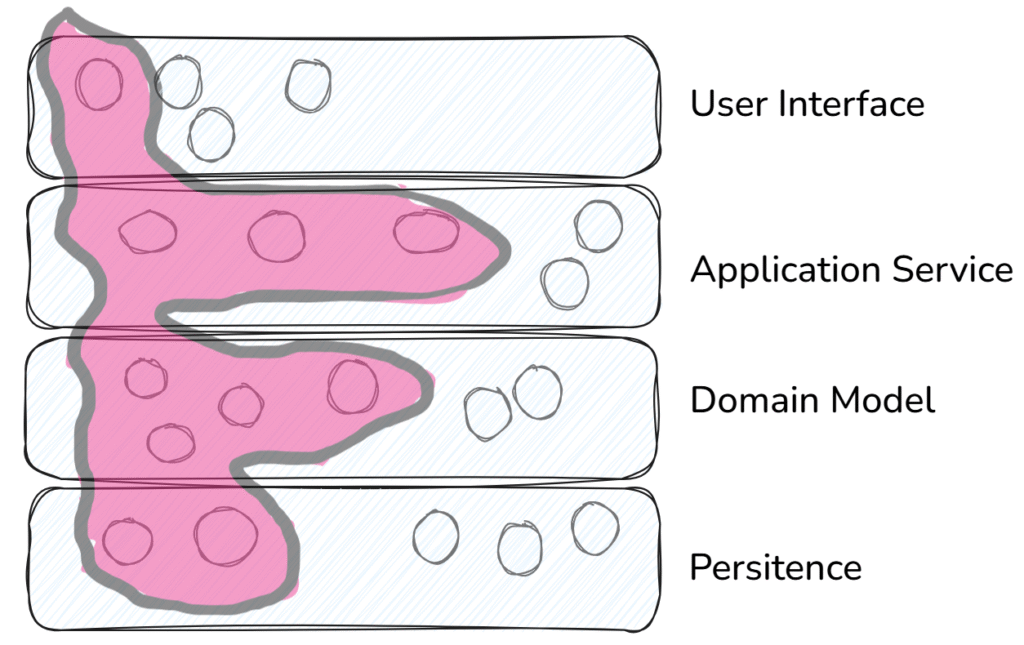
In a majority of software systems, as you can see in the figure 1, we can find that business logic, the very essence of the system’s value, is fractured across disparate technical files, classes, and layers. Key use cases are implemented indirectly, lacking a single, explicit, and cohesive representation of why a particular feature exists. Developers are forced into a constant state of reverse-engineering the system’s technical pathways just to understand or modify fundamental business behavior. It becomes inherently difficult, time-consuming, and error-prone to trace the end-to-end fulfillment of a specific business Goal-Oriented Architecture.
You need to gather multiple pieces of the code from different layers, that works together to fulfill that use case. to provide the whole context for a use case.
These pervasive issues are rarely symptoms of poor individual engineering. Instead, they are often direct side effects of architectural styles that, by prioritizing purely technical concerns and rigid horizontal layering, inadvertently obscure and de-emphasize the core business semantics the software is meant to embody. That’s because software architectures mostly focus on the structure of the system being developed.
2. A Different Philosophy: Re-Centering on Business Purpose
Goal-Oriented Software Architecture begins with a simple, yet profound, reframing question:
What if the very architecture of our software system directly and clearly reflected what the business truly cares about and explicitly stated its core objectives?
Instead of treating crucial business outcomes like “Place Order”, “Approve Loan”, or “Process Customer Refund” as incidental implementations buried deep within a technical hierarchy, Goal-Oriented Software Architecture elevates them. We treat these concrete business objectives as the primary architectural unit and first-class citizens.
In Goal-Oriented Architecture, the concrete business objectives are treated as the atoms of the architecture of the system that holds them!
In this paradigm, a goal is a composable, executable declaration of a singular business intent. It encapsulates everything necessary to evaluate conditions for its execution (preconditions), perform its core logical steps (fulfillment), and manage the consequential outcomes (side effects) of a specific business capability. Critically, there’s no longer a need to scatter logic across unrelated technical layers or disparate services to understand a single business operation. A goal is not merely a handler, nor just a command. It is a self-contained, verifiable, and executable contract of business value. A goal is a composable, executable declaration of a singular business intent.
3.What is Goal Contract? The Contract of Business Value
A goal contract represents a single, cohesive business objective – a use case, expressed declaratively and executed transactionally. Each goal explicitly defines the following contractual elements:
- Preconditions: What definitive statements of truth must hold, or what input data must be valid and present, before this goal can legitimately proceed? (e.g., the customer must exist, items must be in stock, loan application must be completed). Preconditions serve as clear guards.
- Fulfillment: What is the core, immutable business logic and sequence of operations that brings this Goal to its successful completion? This is where the primary value-adding work of the Goal resides. (e.g., place the order, calculate risk and approve loan, generate refund request).
- Side Effects: What observable changes to the system’s state, or what outward-bound actions and notifications should consistently happen once the Goal’s fulfillment is successfully committed? (e.g., reserve inventory items (after placing an order), notify the customer, publish an OrderPlaced event, update inventory levels, log an audit entry). Side effects define the reliable consequences of a Goal’s success.
- State: What minimal data context is specifically involved in the lifecycle of this particular goal’s execution? This represents the crucial data a goal operates on, transforms, or produces as its direct output.
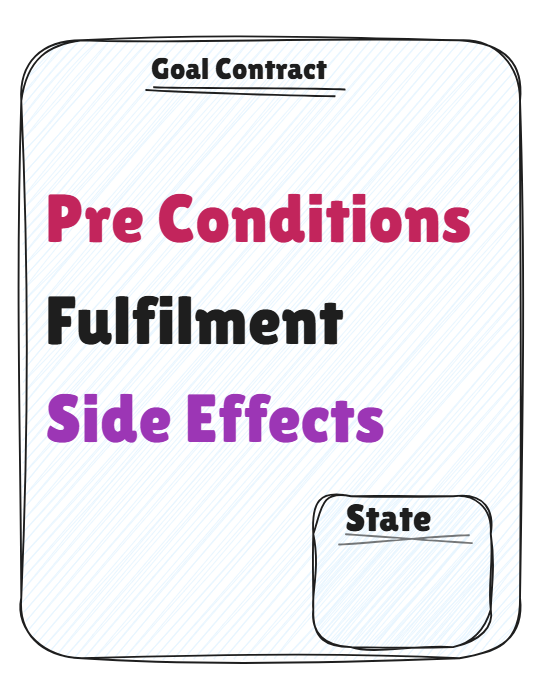
One of the key strengths of Goal-Oriented Architecture is the ability to test each component of a goal independently. Preconditions, fulfillment logic, and side effects are designed as modular units. This means you can validate each part in isolation, ensuring correctness, catching edge cases early, and improving confidence, before composing them into a cohesive goal that expresses a full business intent. This modularity empowers not just developers, but also architects and product teams to reason clearly about behavior and outcomes.
An Example
For example, a PlaceOrder goal contract might contractually define:
- Preconditions: CustomerMustExist, ItemsMustBeInStock, PaymentMustBeAuthorized.
- Fulfillment: PlacingTheOrder.
- Side Effects: NotifyCustomerOfOrderConfirmation, PublishOrderPlacedEvent, UpdateInventorySystem.
- State: OrderId, CustomerId, ListOfItems, TotalPrice, PaymentStatus.
In Goal-Oriented Architecture, each piece- precondition, fulfillment, side effect, is like a puzzle part: testable on its own, powerful when connected.
The goal is far more than a simple function or a method call. It is designed as a living, auditable business object, declared, tracked, and capable of being composed and orchestrated as a single, coherent, and testable unit of business value.
4. Defining Goal Granularity: Striking the Right Balance
A crucial aspect of effective Goal-Oriented Architecture’s implementation is identifying the right level of abstraction for a goal. A Goal should represent a single, cohesive business capability that brings clear, distinct value. We define a Good Goal as one that:
- Aligns with Business Processes: Directly maps to a specific, named step or outcome that business stakeholders explicitly recognize and care about (e.g., Process Loan Application or Initiate Customer Onboarding rather than Validate Data Field).
- Possesses Cohesive Intent: Encapsulates all necessary logic to achieve its specific outcome, minimizing conceptual coupling to unrelated business logic. It represents a clear Why and What.
- Is Transactionally Meaningful: Often corresponds to a logical unit of work that, from a business perspective, either fully succeeds or fails, thereby maintaining system consistency for that particular capability.
- Avoids God Goals: Goals that attempt to do too much, becoming overly large, complex, and unwieldy (e.g., ManageAllCustomerOperations), should be decomposed into smaller, more manageable sub-Goals or a clear composition of distinct, cohesive Goals. Overly large Goals negate the benefits of encapsulation and clarity.
- Avoids Micro-Goals: Conversely to God goals, Goals that are too fine-grained (e.g., ValidateCustomerName or SendEmailConfirmation) lead to excessive boilerplate, cognitive overhead, and cumbersome orchestration. Such minute steps should typically be part of a larger Goal’s preconditions, fulfillment logic, or be standard infrastructure side effects managed generically.
🧠 It’s very rare that sending SMS or notifying a user is considered as a goal from a business perspective, unless you are implementing that domain. I’ll talk more about it later part 10.
5. Implementing Goal-Oriented Architecture: From Concept to Code
To adopt Goal-Oriented Software Architecture effectively and translate its philosophy into production-ready systems, development teams should identify and articulate key business capabilities as goals. This is primarily a collaborative and discovery process involving close collaboration with domain experts. For each identified goal, teams meticulously define its contractual elements, its preconditions, core fulfillment logic, and reliable side effects as a self-contained, cohesive unit. This unit is the atomic representation of the business contract. Then the team should utilize an orchestrator or runner to execute Goals consistently across various external interaction points, such as API calls, message queue events, or scheduled tasks.
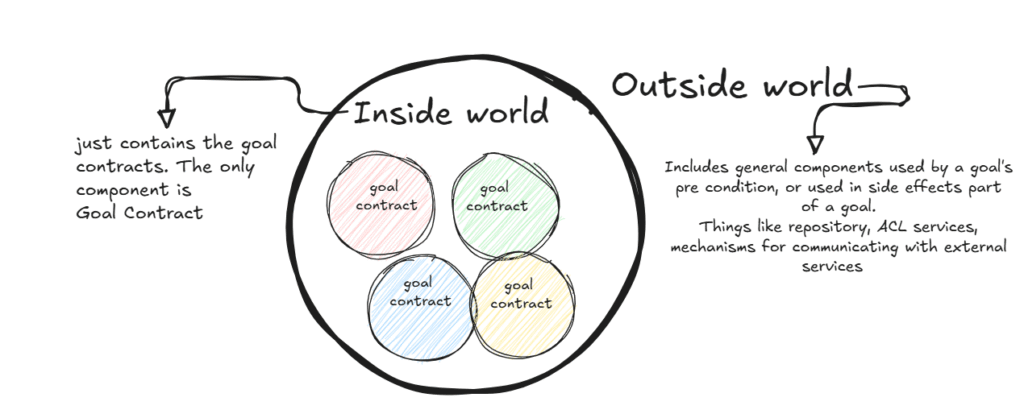
5.1 Goal Execution & Orchestration: The Smart Conductor, Not the Smart Pipe
The Goal Orchestrator
This component serves as a lightweight, intelligent dispatcher and coordinator. It is responsible for receiving goal requests (originating from an API gateway, a message broker, a scheduled job, etc.), validating their preconditions, initiating their fulfillment logic, managing their declared side effects, and coordinating interactions between composed goals within larger business processes. Crucially, the orchestrator’s design must prioritize transparency and explicit control over hidden complexity. It is a conductor, not a black-box magical pipe. Developers must clearly understand how it routes, executes, and manages goals.
Goal as Policy, Orchestrator as Detail
The goal itself represents a high-level business policy. It should declare its needs (e.g., I need a way to persist an order, I need to notify a customer) through abstractions (interfaces or abstract classes), not concrete implementations. The goal orchestrator, or a composition root invoked by it, is responsible for injecting the low-level details and concrete implementations (e.g., a specific database repository, a concrete email service) that fulfill these abstract needs. This ensures the goal remains independent of infrastructure and easily testable.
Transactional Integrity
For complex, long-running business processes that span multiple goals or interact with external systems (which inherently cannot be wrapped in a single, atomic database transaction), Goal-Oriented Architecture leverages Saga related patterns. Each significant step within such a larger business process is itself a goal (or triggers a goal). If a step fails, compensation actions (defined as specific, idempotent goals, or as part of the failed goal’s explicit side effects) are triggered to reverse prior actions and maintain overall system consistency.
We advocate for a flexible approach: utilizing choreography (goals reacting to events published by other goals for simpler, decoupled flows) for its autonomy, and orchestration (a dedicated orchestrator coordinating goals through explicit commands for more complex, long-running processes requiring strict control and explicit flow definition). Transparency in saga state and progress is vital.
Idempotency & Resilience
Goals should be designed to be idempotent where possible, meaning repeated execution with the same inputs yields the same result without unintended side effects. This significantly simplifies retries and error recovery in distributed environments. Standard resilience patterns (e.g., circuit breakers, timeouts, bulkheads) should be rigorously applied to interactions with external systems during goal fulfillment to ensure the overall stability and reliability of the system.
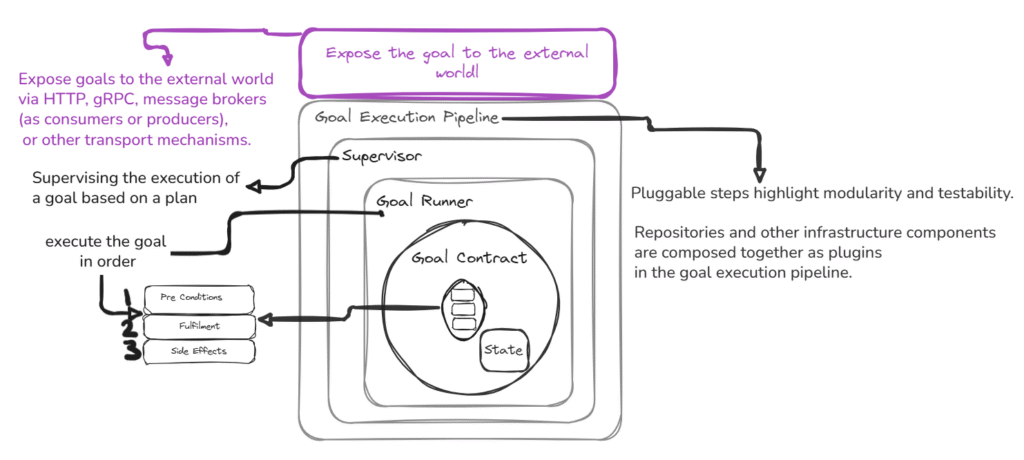
5.2 Goal State Management: Context for Completion
Each goal explicitly defines the state involved in its lifecycle. This state represents the minimal, transient data required for the goal’s preconditions, fulfillment, and side effects. While it’s totally possible for goals to have their own simple, isolated states, for complex scenarios, it’s recommended to design and derive them from DDD’s aggregates. In many cases, the goal’s relevant state directly maps to an Aggregate Root within a Bounded Context of a Domain-Driven Design. The Aggregate Root is the transactional consistency boundary for that domain concept. The goal’s fulfillment then involves interacting with and updating this aggregate root, which manages its own internal invariants and state transitions. The goal acts as the command that operates on the Aggregate. In Goal-Oriented Architecture instead of having a giant order entity/aggregate, it’s common to break it based on goal contract, and as a result each goal contract has its tiny, focused, specific context -bounded state in the form of an entity/aggregate.
For goals that represent long-running processes or multi-step capabilities (e.g., a Loan Application progressing through various approval stages), managing this state robustly is critical. The state in these cases should be ephemeral (execution-bound). For synchronous, short-lived goals that complete in a single atomic operation, state may simply be passed as parameters during a single execution and discarded afterwards. This is the simplest form.
Instead of sharing a massive aggregate among various goals, it’s advisable to divide it into more focused, manageable states, each dedicated to a specific objective.
For long running sagas the state should be managed by a dedicated goal state store/ process manager: For long-running Sagas or complex workflows, a specialized, often event-sourced, data store can track the progress and context of the Goal. This could be a dedicated Saga State entity or a Process Manager that listens to domain events and dispatches subsequent goals.
Consistency models (e.g., strong vs. eventual consistency) should be carefully considered based on business requirements. Typically, strong consistency is maintained within the atomic fulfillment of a single Goal (especially if operating on a single aggregate), while inter-goal communication via events often embraces eventual consistency, acknowledging the distributed nature of complex business processes.
5.4 Addressing Cross-Cutting Concerns: Maintaining Focus
Goal-Oriented Architecture prioritizes keeping core business logic clean, focused, and unpolluted within goals. Other functional concerns (I don’t like the Non-Functional term, but if you prefer it, that’s cool😊) that cut across multiple goals (such as comprehensive logging, security enforcement, validation, coaching, or auditing) should be handled using established modular patterns that respect Goal-Oriented Architecture boundaries and prevent their entanglement with business intent.
Application-Level Middleware/Filters
For concerns applied uniformly across all incoming requests before any goal execution begins (e.g., initial authentication, basic input parsing, request ID logging).
Decorators/Aspect-Oriented Programming (AOP)
To declaratively wrap goal execution with generic concerns like detailed logging, performance monitoring, specific authorization checks, or retry logic. This applies to behavior without modifying the goal’s core code.
Pipeline Behaviors
Frameworks supporting request pipelines are excellent for applying concerns consistently before or after goal fulfillment. These create clear “seams” in the execution flow where concerns can be injected, facilitating fast feedback loops. Examples include comprehensive input validation, transaction management (for single-goal operations), or exception handling.
Centralized Services/API Gateways
For concerns like rate limiting, advanced security policies, request routing, or aggregated logging/monitoring that operate at the system’s perimeter, often before a goal request even reaches the orchestrator. The key principle is to keep these cross-cutting concerns external to the core goal logic, preventing them from polluting or obfuscating the explicit business intent encapsulated within the goal itself.
6. Peripheral Components & Goal Entry Points
In Goal-Oriented Architecture, clarity is achieved not only by elevating business intent but also by drawing a sharp boundary between the system’s core purpose and its execution machinery. This distinction separates the internal, domain-centric logic from external, technology-driven components.
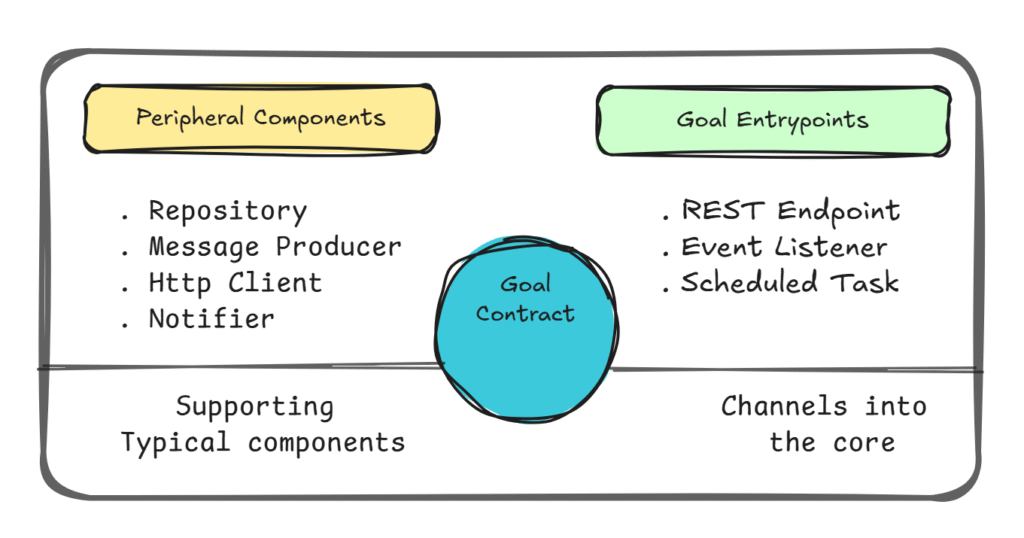
Peripheral components are those parts of the system that support business execution, but do not express or encapsulate any business intent themselves. These components are often:
- Bound to infrastructure or transport mechanisms
- Responsible for I/O operations
- Integrated with third-party services
- Specific to technical protocols or deployment environments
Typical examples include:
- Repositories that abstract database interaction
- Message producers or consumers (e.g., Kafka, RabbitMQ, NATS)
- HTTP or gRPC clients for calling external services
- Email/SMS notifiers for user communications
- File or blob storage clients
- Authentication & token services
They may be used by any part of a goal contract, preconditions, fulfillment, or side effects, to fulfill a business use case, but they do not express or operate within the language of the problem domain itself. Instead, they speak the language of infrastructure and execution mechanics.
This linguistic and functional boundary is a strong signal for separating internal (domain-driven) logic from external (technology-driven) components.
This separation is not just architectural, it’s conceptual. It protects the integrity of the business logic, keeping it clean, expressive, and free from infrastructural noise.
Example
In a PlaceOrder goal:
- Fulfillment might save the order using a PostgresOrderRepository.
- Side effects might publish a OrderPlacedEvent using a Kafka producer and send an email via a NotificationService.
Each of these components operates outside the problem domain but enables the domain to act. They remain replaceable, testable, and loosely coupled through interface boundaries.
6.2 Goal Entrypoints: How the World Interacts with Goals
Goal Entrypoints are the system’s formal interfaces for invoking goals. They serve as a boundary adapter that maps external triggers (such as API calls, message bus events, or scheduled jobs) to goal contracts within the domain.
These entrypoints do not contain business logic. Their sole responsibility is to:
- Interpret external inputs
- Validate formator transport-level concerns
- Forward the request toa Goal Orchestrator for evaluation and execution
Examples of Goal Entrypoints
- A REST API Controller calling SubmitLoanApplication goal when a POST request is received
- A Kafka consumer invoking the StartFraudReview goal when a PaymentAuthorized event is received
- A CRON job triggering the AutoArchiveOldOrders goal at midnight
- A GraphQL mutation dispatching CompleteUserRegistration goal
This separation ensures that goal logic remains untouched by delivery mechanisms. Changing how a goal is triggered (e.g., from HTTP to event-driven) requires no change to the goal itself, only to its entrypoint.
This alignment between architecture and language is foundational to the resilience and clarity of Goal-Oriented Architecture.
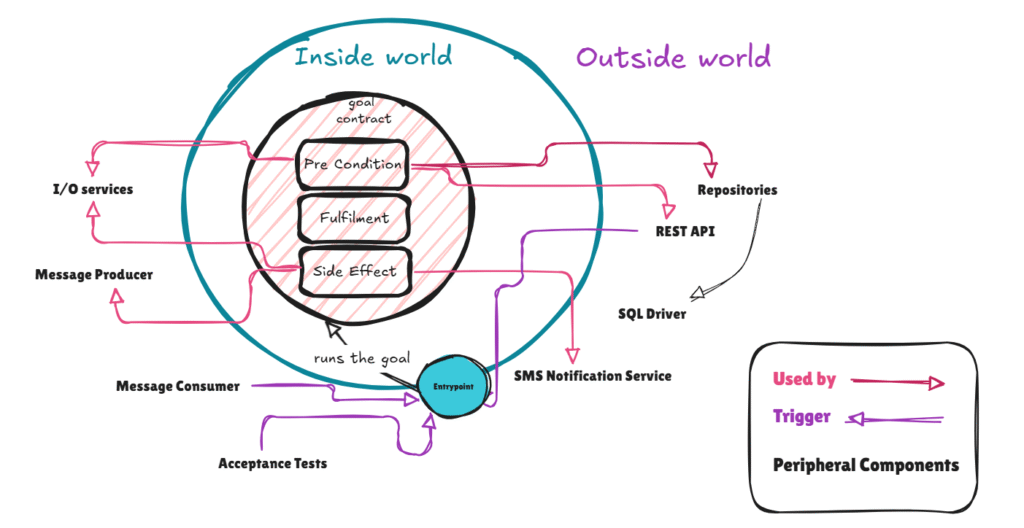
7. Goal Catalog
Goal Catalog is a core part of implementing Goal-Oriented Architecture. It’s a centralized list of business goals that guides service design and team alignment. These contracts guide service behavior and interactions, ensuring alignment with overall system objectives.
The catalog contains explicit goal contracts implemented by services. It defines measurable objectives and conditions for success. It also enables clear communication between services through goal fulfillment. Goal catalog supports modular, goal-driven service design. The Goal Catalog acts as a formalized reference for implementing and managing service goals within GOA.
8.Comparison with Other Architectural Styles: Positioning Goal-Oriented Architecture
Goal-Oriented Architecture is not a rejection of traditional architectural styles but a strategic refinement. It just put the focus and lens somewhere that can result it more manageable software. It changes the anchor of architecting the software and set it to the business intent as a goal itself. It provides a semantically rich building block, the goal, from which systems can be built to more accurately reflect their true purpose.
In Goal-Oriented Architecture, the anchor of architecting the software is the business intent itself as a goal. Architecture of the system that holds them!
8.1 Clean and Onion Architecture
Uncle Bob’s Clean and Jeffrey Palermo’s Onion architecture promote clear layering and the dependency rule, placing business logic at the core, insulated from infrastructure. However, they do not prescribe a standardized, cohesive structure for modeling an entire business capability. Use cases are handled via interactors or application services, but these often remain fragmented, requiring developers to piece together scattered logic to understand a complete business flow.
In contrast, Goal-Oriented Software Architecture offers a single, declarative, and comprehensive structure for each capability, the Goal as a Contract, ensuring that preconditions, fulfillment logic, and side effects are co-located and semantically unified. This explicitly tackles the fragmentation often seen across interactors/application services, providing a clearer, more auditable unit of business value.
8.2 Ports and Adapters (Hexagonal Architecture)
Alistair Cockburn’s Ports and Adapters emphasize the separation of core domain logic from external infrastructure concerns through defined ports (interfaces) and adapters (implementations of those ports). While this significantly helps with testability, evolvability and decoupling, it often lacks a clear semantic modeling of what the core actually does from a business perspective. It defines where logic goes, but not what that logic truly represents in business terms.
Goals, in this model, are a semantic upgrade: not only do they respect the separation of concerns promoted by Ports and Adapters (goals use ports to declare external needs), but they formalize the precise intent and complete lifecycle of each piece of core business logic. They transform abstract ports into explicit business capabilities.
8.3 Vertical Slice Architecture
Jimmy Bogard’s Vertical Slice Architecture promotes organizing code around features (or vertical slices) instead of layers, bundling everything needed to fulfill a request in one place. This is philosophically close to Goal-Oriented Architecture, sharing the desire to avoid fragmented business logic and enhance feature-centric development.
However, Vertical Slices often remain largely procedural, they execute logic, but they may not explicitly define a formalized lifecycle model for preconditions, fulfillment, and consequences as a strict contract. Goal-Oriented Software Architecture offers more structure, semantic richness, and a clear contractual definition for each slice, making it a more robust, testable, and semantically explicit executable business unit.
9. One Scenario, Multiple Software Architecture Perspective: It’s Time to Comparison on the Ground
In the following I’ll go through a near-real complex example, showing how it is implemented in different schools of thought of well-known software architecture, in order to compare them.
Consider the complex, multi-step business process of approving a loan:
Layered-Styles Software Architecture System
- A LoanController handles the incoming HTTP request.
- A LoanApplicationService orchestrates calls:
- ApplicantValidationService.Validate(applicantData)
- CreditScoreService.Check(applicantId)
- LoanCalculationService.CalculateEligibility(score)
- A WorkflowEngine might be invoked to trigger a separate approval process.
- NotificationService and AuditLogRepository calls are scattered across various service methods.
Understanding the full Loan Approval business process requires manual tracing through multiple technically organized components, often fragmented across different files and even deployment units.
Goal-Oriented Software Architecture
An ApproveLoan Goal defines the entire flow as a single, cohesive, and auditable unit:
Preconditions:
- HasValidApplication: Applicant data is complete and correctly formatted.
- CreditScoreAboveThreshold: Applicant’s credit score meets minimum requirements.
- NotAlreadyApprovedOrRejected: Loan application is in a pending state.
Fulfillment:
- EvaluateRiskAndDetermineApproval: Core logic to assess risk and make the approval decision.
Side Effects:
- PersistLoanApprovalStatus: Update the loan application’s status in the system.
- Notify ApplicantOfDecision: Send an email or SMS to the applicant.
- Log AuditEntryForApproval: Record the approval details for compliance.
- Publish LoanApprovedEvent: Emit a domain event for other systems (e.g., Loan Disbursement, CRM).
State (for this goal’s execution):
- LoanApplicationId, ApplicantId, CreditScore, ApprovalStatus, DecisionDate.
This ApproveLoanGoalContract is a complete, self-contained unit. Its contract clearly defines its inputs, outputs, and effects. It can be easily tested in isolation, simulated for what-if scenarios, rigorously logged, composed with other Goals (e.g., as part of a larger CustomerOnboarding saga), and orchestrated by the central dispatcher, all as a single, understandable architectural unit that directly mirrors business intent.
10. What Should and Shouldn’t Be a Goal?
Not every action in a software system is worthy of being a standalone goal. Goals are not tasks, they are declarations of business intent, not technical execution steps.
In GOA, a goal should reflect why the system exists from a business point of view, not just what it does at a technical level.
Treat as Goals:
The following types of actions should be treated as goals:
- Approve a refund
- Cancel an order
- Register a user
- Initiate a payout
- Assign a delivery driver
Each of these represents a business-level intent that usually spans multiple operations, has real-world meaning, and is important to a stakeholder or customer. They have preconditions, lead to state changes, and often produce observable side effects.
Not a Goal, But Still Important
These are side effects, supporting steps, or infrastructure concerns:
- Send SMS to customer
- Notify order creator
- Publish domain event
- Save data to a database
- Write an audit log
- Invalidate a cache
While critical, these actions do not express intent. Instead, they are outcomes or effects of an intent and should be attached to the goal contract under the Side Effects phase. By making these responsibilities explicit but not central, GOA helps surface them clearly while keeping the architectural focus on what really matters: business behavior.
For instance: Send SMS to the order creator is not a goal. But Cancel Order might be. The SMS is a side effect of fulfilling that goal.
This distinction avoids over-engineering trivial tasks into full-blown goals while ensuring that side effects are not hidden behind implicit logic. It improves traceability, testability, and business alignment across the architecture.
A goal captures intent-purpose; sending emails or saving data are consequences, not of an intent, purpose.
11. Why Goal-Oriented Software Architecture Matters: Tangible Benefits
In complex, evolving systems, preserving clarity of business intent is crucial to the success of the system in fulfilling of their expectation from the problem/business point of view, and often the first casualty amidst layers of technical abstraction. Architectural styles that separate responsibilities horizontally (controllers, services, repositories) frequently bury critical business capabilities beneath technical concerns.
Goal-Oriented Architecture proactively restores them to the surface, offering concrete advantages:
A Shared Mental Model Between Business and Engineering
By explicitly defining goals in business terms, the architecture directly speaks the language of the business. This eradicates miscommunication, fosters tighter alignment between product and technical teams, and ensures that everyone understands the system’s purpose.
A Repeatable, Testable Unit of Business Logic
The rigorously encapsulated nature of a goal dramatically simplifies testing. You can comprehensively test a business capability in isolation by defining its preconditions and asserting its fulfillment outcomes and side effects (outputs/consequences). This directly supports Test-Driven Development (TDD): write a failing test for a goal’s expected behavior, then implement the goal until the test passes. This leads to higher confidence in changes, faster feedback cycles, and more robust systems, providing clear seams for testing.
A Strategy for Incremental Adoption
Goal-Oriented Architecture can be introduced pragmatically into existing, brownfield systems without requiring a full-scale rewrite. New features or refactored legacy modules can be built as goals, gradually replacing or wrapping older functionalities using patterns like the Strangler Fig. This allows for a pragmatic, low-risk evolution towards a business-centric architecture, demonstrating value iteratively.
Scales Complexity without Obscuring Intent
By clearly defining independent business capabilities, Goal-Oriented Architecture enables independent development and potential independent deployment of goals (like feature-focused microservices). The explicit orchestration patterns allow for managing the inherent complexities of distributed systems (e.g., transnationality, error recovery) while maintaining a clear, auditable understanding of the overall business process flow. This shifts complexity from implicit, scattered logic to explicit, manageable orchestration patterns.
Enhanced Modularity & Encapsulation
Each goal is a self-contained unit. This strong encapsulation reduces inter-module dependencies at the conceptual level, promoting cleaner codebases and reducing spaghetti logic.
Goal-Oriented Architecture elevates business intent as the primary driver of software structure, design and behavior.
11.1 Tooling and Ecosystem Outlook: Leveraging Existing Strengths
While Goal-Oriented Architecture is a paradigm rather than a specific framework, it is highly compatible with and can strategically leverage existing tools from the broader software ecosystem.
Orchestration: Established workflow engines (e.g., Camunda) can facilitate robust orchestrator implementation, particularly for complex sagas. Message brokers (e.g., Kafka, RabbitMQ) are ideal for implementing event-driven side effects and choreography.
Domain Modeling: Domain-Driven Design (DDD)-focused patterns can aid in modeling underlying domain aggregates that goals operate on, integrating seamlessly.
The explicit, contractual nature of a goal (with its defined preconditions, fulfillment, and side effects) also opens up exciting possibilities for future tooling. This includes automated validation of goal contracts, visual representation of complex business processes based on goal compositions, and even AI-assisted code generation for common goal patterns, potentially streamlining development even further. While initial adoption might involve more custom infrastructure or adaptive use of existing tools, the inherent clarity and formalization of the Goal-Oriented Architecture model provides a strong and fertile foundation for future innovation and dedicated tool development.
12. Navigating the Trade-offs: A Pragmatic View
No architectural style is a silver bullet; each involves inherent trade-offs. A rational adoption of Goal-Oriented Architecture requires acknowledging and strategically managing these considerations:
Increased Upfront Design for Goal Definition: While beneficial in the long run, meticulously defining all elements of a goal (preconditions, fulfillment, side effects) requires a more deliberate upfront analysis phase compared to simply coding a service method. This can feel like a ceremony for teams accustomed to less formal approaches.
Complexity Shift to Orchestration: Goal-Oriented Architecture doesn’t eliminate complexity; it shifts it from fragmented business logic to the design, implementation, and operation of the Goal Orchestrator. A poorly designed orchestrator can become a black box or a single point of failure, requiring significant architectural rigor and operational maturity.
Potential for Boilerplate: For very simple CRUD-style operations, the full goal contract might introduce more boilerplate than a simple repository method. Teams must develop heuristics for when a dedicated goal is truly warranted (e.g., when it represents a distinct business transaction or capability), versus when a simpler pattern suffices within a Goal’s fulfillment.
Learning Curve: Adopting Goal-Oriented Architecture requires a new mental model for developers, particularly juniors. Shifting from technical layering to business-Goal thinking demands focused training, strong mentorship, and clear examples to avoid initial productivity dips.
13. Conclusion: A Clear Path to Business-Centric Software
Goal-Oriented Software Architecture is not a rejection of common/traditional styles, but a powerful, necessary refinement. It systematically addresses the pervasive issue of business logic fragmentation, bringing structure where there was sprawl, clarity where there was obscurity, and explicit purpose where there were only methods. It doesn’t aim to replace every pattern or technique, but rather provides a semantically rich, cohesive, and highly understandable building block, the goal, from which systems can be built to more accurately reflect their fundamental business purpose and intent. This approach yields software that is not only functional and robust but also transparent, maintainable, and inherently aligned with the strategic objectives it serves.
14. The Path Forward: Embracing Intent through Evolution and Collaboration
The chronic misalignment between software structure and explicit business needs is a persistent challenge for organizations striving for agility, clarity, and rapid response to market demands. Goal-Oriented Software Architecture offers a compelling solution, providing a practical blueprint for designing systems that inherently communicate their purpose and value.
For development teams and architects considering this paradigm, I advocate for structured and pragmatic adoption:
Start Small, Learn Fast: Begin by applying Goal-Oriented Architecture to new, self-contained features or modules within an existing system. This allows for controlled experimentation, internal learning, and demonstrating tangible value without disrupting established, large-scale workflows. Do not attempt a “big bang” rewrite.
Invest in Domain Understanding: Prioritize intensive, collaborative discussions with business stakeholders and domain experts to truly understand and meticulously define core business Goals. This deep understanding, fostered through Ubiquitous Language and analysis of Bounded Contexts, is the absolute foundation upon which effective Goal-Oriented Architecture implementation rests.
Focus on a Robust Orchestrator Design: Dedicate significant design and engineering effort to the goal orchestrator. Its robustness, observability, transparency, and ability to handle complex flows and failures are paramount to Goal-Oriented Architecture’s success in a production environment. Avoid magic, ensure the orchestrator’s behavior is explicit, auditable, and testable.
Cultivate a Shared Language: Consistently use the goal terminology across engineering, product management, and business teams. This fosters a truly ubiquitous language for system behavior, improving communication, reducing ambiguity, and accelerating shared understanding across the entire organization.
Empower Developers: Provide clear documentation, actionable code examples (e.g., in a common language like C# or Java), and visual diagrams (e.g., sequence diagrams for goal execution, component diagrams showing Goal-Orchestrator interaction) to bridge the gap between high-level concepts and daily coding. Establish clear guidelines for Goal granularity and best practices.
Wrap-up:
Goal-Oriented Software Architecture is more than just a technical pattern; it is a philosophy that fundamentally re-centers software design on its ultimate purpose: to explicitly enable and amplify business capabilities. By embracing Goals as first-class citizens, we can build software that is not only functional and robust but also transparent, understandable, maintainable, and inherently aligned with the strategic objectives it serves. The time for business-centric system design is now, and Goal-Oriented Software Architecture provides a clear, principled path to achieve it.
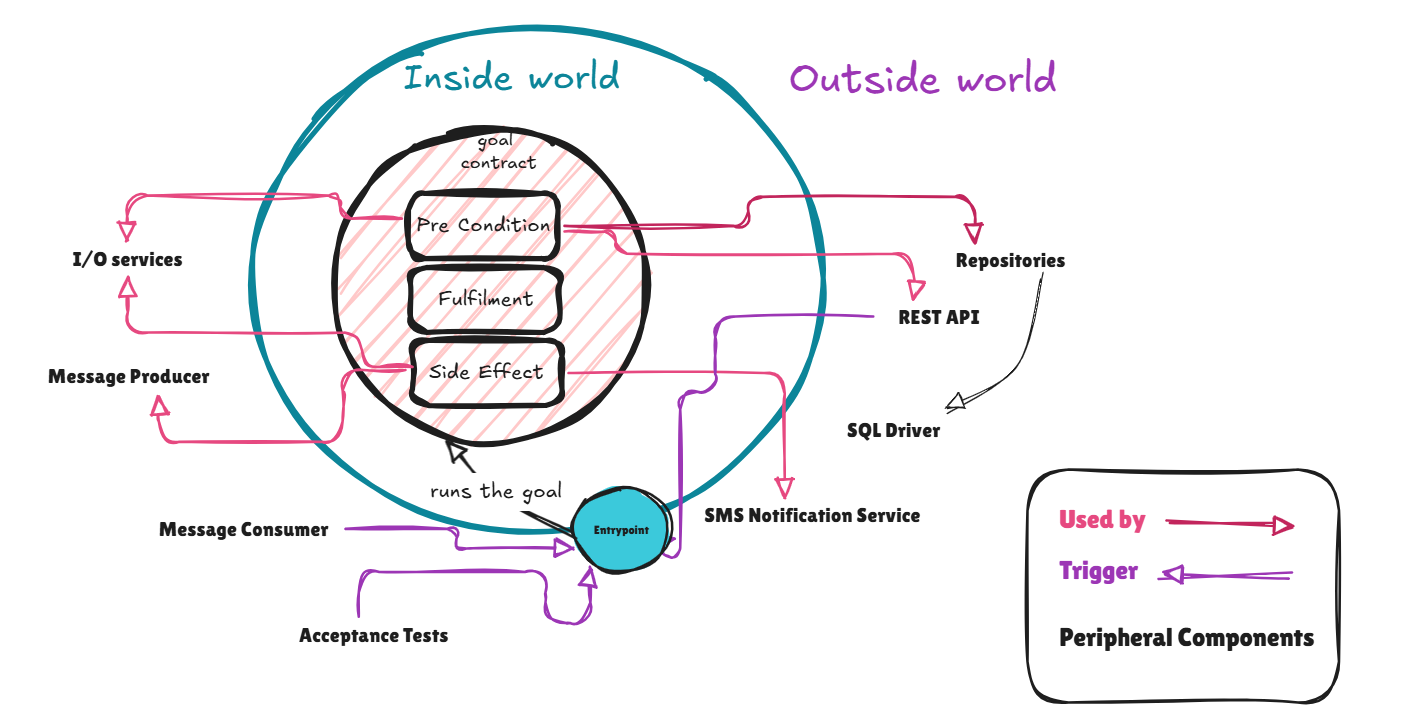
Leave a Reply